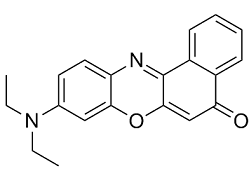All AbMole products are for research use only, cannot be used for human consumption.

Nile Red is a strongly fluorescent stain in the presence of a hydrophobic environment for the detection of intracellular lipid droplets.
Mice Brain Tissues Nile Red Staining
1. Mouse tissue harvesting
Central nervous system tissues, including optic nerves (12 male mice, 15 weeks old), brains (31 mice, 3 female and the rest male mice, 6 were 31 weeks old, the rest were 13–15 weeks old), and dorsal columns (8 male mice, 15 weeks old), were harvested with the protocol varying based on the developmental stage of the mice (neonatal vs. adult). Adult animals were deeply anesthetized by 600 mg/kg of sodium pentobarbital. Intracardiac perfusion was performed with 12 mL of room‐temperature phosphate‐buffered saline (PBS), followed by 12 mL of ice‐cold 4% paraformaldehyde (PFA). Tissues were then postfixed in 4% PFA at 4°C overnight. Cryoprotection was achieved through a sequential sucrose treatment, initially in 20% sucrose, until tissue descent, followed by immersion in 30% sucrose. Brain tissues were then encapsulated in an optimal cutting temperature compound and frozen in isopentane cooled by dry ice. Coronal sections ranging from 20 to 100 μm thickness were cut using a cryostat and collected on VWR Superfrost Plus Micro Slides, ensuring three region‐matched sections per slide. For optic nerves and dorsal columns of adult mice, a similar perfusion and fixation protocol was employed. A 1.2 cm segment of the cervical spine was excised and either fixed as above or transferred for live imaging. Dorsal roots and sciatic nerves were harvested in a similar manner. Five neonatal male mice were euthanized by exposure to 10–15 min of profound hypothermia/hypercarbia using an ice block placed in a CO2 chamber, after which their movement gradually ceased and rigor set in. At this time, a tail pinch test was conducted to confirm unresponsiveness to deep pain, then animals were sacrificed by decapitation, and dorsal roots and sciatic nerves were carefully harvested with minimal delay.
2. Nile Red staining
A stock solution of NR (M5118) was prepared at a concentration of 6 mM in dimethyl sulfoxide (DMSO) and stored at −20°C for future use. Depending on the type of specimen (e.g., brain sections vs. intact optic nerves), the working concentration of NR varied from 10 to 40 μM in PBS. Fixed frozen tissue sections were stained with NR for a duration of 10 min, followed by a 5 min wash in PBS to remove excess dye. Subsequently, the stained tissue sections were placed in a PBS bath on a glass microscope slide for imaging. A water‐immersion objective was employed without mounting media or coverslips.

Adv Sci (Weinh). 2025 Feb 07.
PLIN2 Promotes Lipid Accumulation in Ascites-Associated Macrophages and Ovarian Cancer Progression by HIF1α/SPP1 Signaling
Nile Red purchased from AbMole

Toxins. 2025 Apr 26;Yue Meng.
TM9SF2 Maintains Golgi Integrity and Regulates Ricin-Induced Cytotoxicity
Nile Red purchased from AbMole

Cell Death Discov. 2024 May 1;10(1):207.
TM7SF2-induced lipid reprogramming promotes cell proliferation and migration via CPT1A/Wnt/尾-Catenin axis in cervical cancer cells
Nile Red purchased from AbMole

Gastric Cancer. 2020 Mar;23(2):241-259.
The modification of ferroptosis and abnormal lipometabolism through overexpression and knockdown of potential prognostic biomarker perilipin2 in gastric carcinoma.
Nile Red purchased from AbMole
| Molecular Weight | 318.37 |
| Formula | C20H18N2O2 |
| CAS Number | 7385-67-3 |
| Solubility (25°C) | DMSO ≥ 30 mg/mL |
| Storage | 4°C, protect from light |
| Related Fluorescent Dye Products |
|---|
| 4-MUNANA
4-MUNANA is a substrate of influenza virus neuraminidase (NA) with high selectivity and irreversible reaction. In the enzymatic reaction, 4-MUNANA is hydrolyzed by NA to generate fluorescent 4-methylumbelliferone (4-MU). By detecting the fluorescence intensity of 4-MU, quantitative analysis of NA activity can be achieved. |
| FITC Palmitate
FITC-Palmitate is a fluorescently labelled fatty acid derivative made by chemically coupling fluorescein isothiocyanate (FITC) with a long chain fatty acid, palmitic acid. Due to its combination of fat solubility and green fluorescent signals, it has a variety of uses in biomedical and cell biology experiments. |
| PGSK diacetate (5/6-mixture)
PGSK diacetate (5/6-mixture) is a metal ion-sensitive fluorescent probe that can penetrate cell membranes. PGSK diacetate can react with a variety of metal ions, including Fe2+, Cd2+, Co2+, Ni2+, Zn2+, etc. PGSK diacetate chelates Fe2+, resulting in fluorescence quenching, which can be restored when a membrane-permeable chelator is added, thereby reflecting the changes in the intracellular chelatable iron pool. The excitation/emission maxima of PGSK diacetate are 507/532 nm, respectively. |
| Dextran-Rhodamine B
Dextran-Rhodamine B (RB-Dextran) is a fluorescent marker made by combining rhodamine B fluorescent dye and dextran polysaccharide through a specific chemical reaction. RB-Dextran is a red fluorescent modified dextran polysaccharide formed by chemically labeling rhodamine B onto dextran molecules, which can be used in cell tracing, biofluid dynamics research and other fields, and its fluorescent properties can be used to track the distribution and metabolism of dextran in organisms and other processes. |
| N-Succinimidyl 6-(2,4-Dinitroanilino)hexanoate
N-Succinimidyl 6-(2,4-Dinitroanilino)hexanoate, the DNP-X acid modified by succinimidyl ester, is an amine-reactive building block for developing a probe, which can be recognized by anti-DNP antibodies. |
All AbMole products are for research use only, cannot be used for human consumption or veterinary use. We do not provide products or services to individuals. Please comply with the intended use and do not use AbMole products for any other purpose.


Products are for research use only. Not for human use. We do not sell to patients.
© Copyright 2010-2024 AbMole BioScience. All Rights Reserved.
